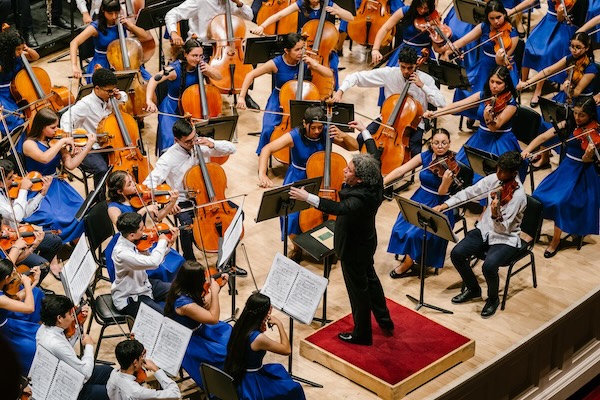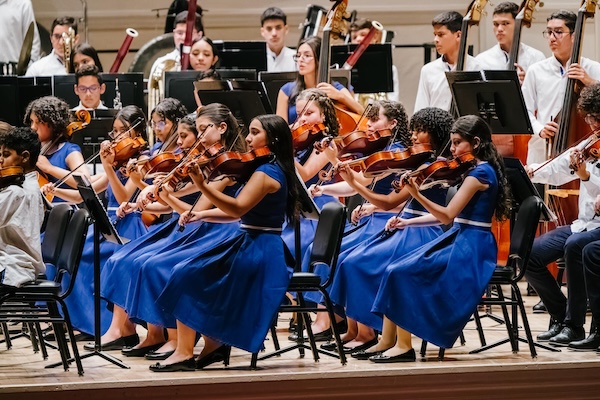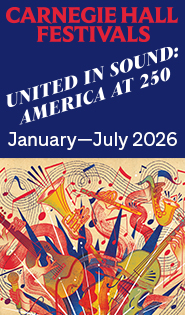Dudamel, Venezuelan youth orchestra tear the roof off at Carnegie Hall

When people get together to celebrate with music, it may be a party, but it’s usually called a concert. That’s what went on at Carnegie Hall Friday night for the second World Orchestra Week (WOW!) performance, this one from the National Children’s Symphony of Venezuela, led by conductor Gustavo Dudamel.
This was a three-fold celebration: future New York Philharmonic music director Dudamel was awarded the Glenn Gould Prize in a shambolic ceremony after intermission; there was the joy of witnessing the passion and skill of young musicians; and there were piquant embraces of Venezuelan national identity. The last came through in Dudamel dedicating his award to “the youth of my beautiful country,” Venezuelan music itself, and the audience, which came to cheer on these talented young people.
If the corruption and dictatorship repressing Venezuela this very week is the worst of the country, this youth symphony—the product of the country’s famous EL Sistema music education—is the best. The orchestra played, and sang its heart out in a program of John Adams, Antonio Estévez, Alberto Ginastera, and Shostakovich, plus encores. This was a vibrant experience almost all the way through.
This is a huge orchestra—there are 173 names in the program—and the wallop of sound in Adams’ Short Ride in a Fast Machine was invigorating. More than volume, there was the tremendous excitement coming out of each musician. The crisp playing and articulation from such a massive ensemble was impressive, and this was blistering playing and jaw-dropping fun. They gave up nothing in terms of precision, and this was both the most exciting playing one has heard in this work, and the one that felt truest to the style and expression of the music.
Things cooled down with Venezuelan composer Estévez’s Mediodía en el llano, a gentle orchestral tone poem. One major difference between a youth orchestra and a professional one is that latter has a mastery of the types of subtle instrumental techniques, earned through time, that can produced varied timbres and atmospheres. One sensed there was more mystery in the music that came out in the playing, but it was still a sweet and lovely performance.
What followed was an off-the-program interlude: two short chorale works from Jose Antonio Abreu, Dudamel’s mentor and the founder of El Sistema. The conductor announced these from the stage, and this brought a shouted “Venezuela libré” and a thunderous cheer from the audience. Sol que das vida a los trigos and a Gloria, were sung by the orchestra, which for a few minutes sounded like the world’s finest youth chorus.
The energy ramped back up with Ginastera’s Four Dances from Estancia, a 1941 work originally commissioned by Lincoln Kerstein. The music captures pictures of a day in the life of gauchos in the pampas, a kind of Argentina version of Copland. That meant dance rhythms and exuberant lyricism. This was the orchestra at its best, playing with great swagger and sense of fun, swaying in their seats and raising their instruments in time with the steps of the final “Mambo.”
One would rather young musicians not yet be expert in Shostakovich for their own well-being; the hollowed-out terrors and emotional ambiguities are best saved for adults. Even without those last measures of expression, this was an excellent performance of the Fifth Symphony, the orchestra hitting every mark and wielding great dynamic range.
The opening movement was sturdy and skillful, just lacking the complete desolation of the closing measures. The Allegretto was brilliant, with a sincere spirit that brought out the sardonic nature of the music. From the oboe solo in the Largo, things turned magical, the playing moving to a higher level of care and concentration that set up a dramatic transition to the finale, Dudamel setting a tempo closer to vivace. Tempo marking be damned, this was thrilling for the way the orchestra handled the tempo and brought out a massive yet controlled sound for the final, haunting fanfares.
Then, the encores. First, Aldemaro Romero’s extensive Fuga con pajarillo. After the fire of the Shostakovich, the orchestra sounded slightly mushy, though the spirit was still substantial. In the middle of this piece was an extensive solo section for the Alma Llanera Ensemble, a quartet of Llanera harpist Emily Bogado, bassist Stefani Diaz, cuatro player Deogo Casanova, and percussionist Paola Mendoza playing the Venezuelan maracas. This was one hot group, with tremendous rhythmic suavity and brilliant solos from Casanova and Mendoza, the set coming off as a concerto with as much meat as anything on the regular program.
With the heat in Carnegie still high, the audience demanded more, and got the “Mambo” from Leonard Bernstein’s West Side Story dances. It was fittingly the most explosive moment of the concert.
World Orchestra Week continues with the Africa United Youth Orchestra, conductor William Eddins, and sopranos Masabane Cecilia Rangwanasha and Goitsemang Lehobye performing Dvořák’s Symphony No. 9 and other works 7 p.m. Saturday. carnegiehall.org


